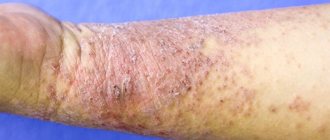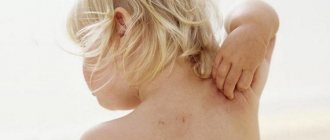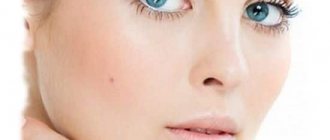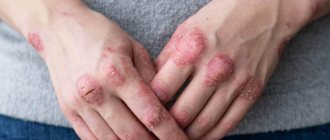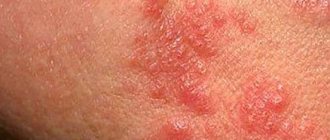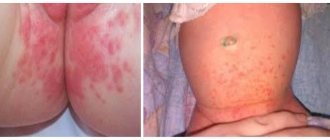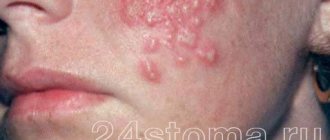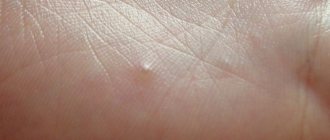What is atopic dermatitis
Atopic dermatitis is a chronic skin disease characterized by a relapsing course.
Babies with atopic dermatitis are bothered by itching and dry skin. Foci of inflammation can be located throughout the body, but they especially “love” children’s cheeks and folds, as well as the area under the diaper. Statistics indicate that atopic dermatitis occurs in every fifth baby [1]. Why is he dangerous? Lack of treatment can lead to the development of severe forms of atopic dermatitis, the spread of inflammation and the atopic march. In this condition, the disease begins to “march” through the child’s body, provoking the appearance or exacerbation of concomitant diseases. In 20-43% of cases, the development of bronchial asthma is possible, and twice as often - allergic rhinitis or eczema [2].
In addition, disruption of the hydrolipid barrier that occurs with atopic dermatitis in children can cause a secondary infection. Unfortunately, atopic dermatitis cannot be “outgrown.”
Symptoms and signs of the disease
As a rule, at the initial stage the signs of one or another dermatitis are the same. Redness occurs on the surface of the skin, followed by rashes, swelling, dryness and cracks. They often itch, and patients also often complain of a burning sensation and pain in the affected area. Manifestations of contact skin pathology are usually less pronounced, while the allergic form is characterized by more severe redness and swelling. Often liquid-filled blisters appear on the affected area. If they are damaged or burst, this can lead to the formation of large, weeping lesions, which can be accompanied by a secondary infection. In this case, the sites of inflammation will begin to fester, which will lead to a more severe course of the disease and its progression to a chronic form.
A clear symptom of an allergic reaction is skin lesions not only at the site of contact with the irritant, but also on other surfaces. The skin most often exposed to pathogens is the skin of the hands, face, neck, shoulders, collarbones, armpits and scalp. Allergic dermatitis rarely affects the lower limbs and torso.[3].
Symptoms of atopic dermatitis in children
According to recent studies [3], in 45% of babies, atopic dermatitis debuts between the ages of two and six months. In 60% of patients during the first year of life.
With atopic dermatitis in children, clinical symptoms and localization of inflammation largely depend on age. There are infant (up to one and a half years), child (from one and a half years to puberty) and adult phases. The following symptoms are common to all phases:
- Severe dryness of the skin (xerosis), which cannot be treated with regular baby cream .
- Redness and inflammation on the skin (especially symmetrical ones).
- Itching, causing severe discomfort to the child.
- Recurrent course (alternating periods of remissions and exacerbations). Moreover, in the cold season, deterioration is more often observed, and in the warm season, improvement is observed.
According to the nature of the course, acute and chronic stages of atopic dermatitis are distinguished, which are expressed by different signs (symptoms):
● Acute stage. Rough red spots (erythema), nodular rashes (papules), swelling, and crusts (including weeping) may appear on the baby's skin.
● Chronic stage. Accompanied by lichenification (thickening of the skin), cracks on the soles and palms, scratching, and increased pigmentation of the skin of the eyelids.
Causes of atopic dermatitis in children
Atopic dermatitis can be considered a hereditary disease, because the most important role in its occurrence is played by a genetic factor [3]:
- In 80% of children, it occurs if both parents have or have had atopic dermatitis.
- In more than 50% of children - if at least one of the parents was sick, especially the mother (this doubles the risk of transmitting the disease “by inheritance”).
Some prenatal factors can also provoke atopic dermatitis in a baby: for example, poor nutrition of the expectant mother, contact with toxic substances, infections suffered during pregnancy, as well as bad habits and stress.
In addition, atopic dermatitis more often develops in babies who suffered oxygen deprivation during childbirth, were born prematurely and were bottle-fed (perinatal factors).
Diagnosis of atopic dermatitis in children
For a long time it was believed that atopic dermatitis in children is predominantly an allergic disease. However, it has now been proven that this is, first of all, a disease with dysfunction of the epidermis! And food allergies are detected only in 30-40% of children with atopic dermatitis.
The symptoms of atopic dermatitis are almost always influenced by certain environmental triggers. This could be chlorinated or “hard” water, soap, contact with an allergen, unfavorable climate and even stress. Another common trigger is bacteria that enter the skin through a damaged epidermal barrier.
Only a doctor (pediatrician, dermatologist, allergist) can make a diagnosis of “atopic dermatitis in children”! It takes into account the presence of external signs of disease and itching, as well as hereditary factors. Laboratory tests may be prescribed for children to carry out diagnostics. For example:
- General detailed (clinical) blood test.
- Biochemical general therapeutic blood test.
- General (clinical) urine analysis.
- Study of the level of total immunoglobulin E in the blood.
- Skin testing with allergens.
- Skin biopsy.
Treatment of atopic dermatitis in children
In modern medicine, there are three degrees of severity of atopic dermatitis in children:
- Easy. The child responds well to treatment, remission can last more than 10 months, the itching is minor, the redness is slight. Exacerbations occur no more than twice a year.
- Medium-heavy. Exacerbations occur 3-4 times a year, and periods of remission are reduced to 2-3 months. The therapy gives less pronounced results, the redness “stubbornly” returns.
- Heavy. Long-term exacerbations are interrupted by short periods of remission - up to one and a half months. Treatment helps little or for a short period of time; the baby’s behavior is greatly affected by itching [4].
At all stages of atopic dermatitis, pediatricians and dermatologists recommend emollients - cosmetic skin care products. They moisturize the skin and help restore the level of lipids - the most important structural components. During periods of exacerbation, emollients can be applied frequently and generously.
Pay attention to the composition; it is advisable that emollients are not addictive. Their main tasks are to help the skin produce its own lipids, providing effective hydration and softening. In addition, the constant use of emollients prolongs periods of remission and alleviates the symptoms of atopic dermatitis.
The Mustela Stelatopia line of cosmetics will help restore skin comfort for a long time! Stelatopia emollients are effective at all stages of atopic dermatitis , incl. at its first signs - increased dryness of the skin.
Studies have confirmed that the use of Stelatopia emollient cream can reduce the likelihood of developing atopic dermatitis by 51% ! [6]
Treatment (use of hormonal drugs) for atopic dermatitis in children can only be prescribed by a doctor, taking into account age, symptoms, concomitant diseases and test results. Self-medication can be dangerous!
- For external therapy for moderate and severe degrees of atopic dermatitis, topical glucocorticosteroids, topical calcineurin inhibitors and others are used.
- In case of mild disease, the use of Stelatopia Emollient Cream reduces the severity of inflammation after 32 hours, due to the presence of sunflower oil in the distillate [5].
- In systemic therapy, the drugs dupilumab, cyclosporine, glucocorticosteroids and others are used orally or in injection forms.
- To relieve itching - clemastine, hifenadine, cetirizine, chloropyramine, levocetirizine and others. The use of Stelatopia emollient cream as a cosmetic skin care product reduces the severity of itching in 80% of cases [7].
- Physiotherapy treatment may include phototherapy. Sometimes, in the treatment of atopic dermatitis, diet therapy, acupuncture, plasmapheresis and some other methods may be prescribed.
Causes and types of dermatitis
The disease occurs when the protective function of the skin is weakened due to prolonged exposure to aggressive substances or decreased immunity. The cause of the pathology can be the following factors:
- mechanical irritation, friction, compression of the skin;
- thermal burn or frostbite, ionizing, UV and other radiation, electric current;
- contact with chemicals contained in skin care products, household chemicals, decorative cosmetics, as well as salts of heavy metals, acids or alkalis, medications for external use;
- allergic reaction to plant pollen, animal hair, food, medications;
- infection with viruses, bacteria or fungi;
- taking antibiotics, sulfonamides, novocaine-containing drugs;
- systemic diseases, hormonal disorders, hypovitaminosis, pathology of the digestive organs, liver, disorders of carbohydrate and fat metabolism, helminthic infestation, influenza and ARVI.
According to etiological factors, there are:
- Perioral dermatitis. It occurs due to the abuse of cosmetics, improper local use of hormonal drugs, the use of medicated fluoride-containing toothpastes, hypovitaminosis A and E. In childhood, it appears with increased salivation and during teething.
- Atopic dermatitis. Occurs mainly in children prone to allergic reactions and has a hereditary predisposition. Irritants may include foods, allergens of plant or animal origin, dust mites, Staphylococcus aureus enterotoxins, and mold fungi. Rashes in a child of the first years of life are localized mainly on the face and extensor surfaces of the limbs, and at an older age and in adults, dermatitis appears on the elbows and popliteal folds.
- Contact allergic dermatitis. Appears when the skin comes into contact with substances to which the immune system is sensitized. May develop at lightning speed and be accompanied by anaphylactic shock.
- Actinic dermatitis. An allergic reaction to ultraviolet radiation, also known as sun allergy.
- Drug dermatitis. Occurs as a reaction to the use of medications (iodine, brilliant green).
- Seborrheic dermatitis. The cause of the disease is fungi of the genus Malassezia. Exacerbation occurs in hot and humid weather, with stress, hormonal, immune and neuroendocrine disorders, when the activity of the sebaceous glands increases. In places where they accumulate, the symptoms are more pronounced. Most often, seborrheic dermatitis affects the scalp, face, and upper third of the body.
- Infectious dermatitis. It develops when the skin is damaged by pathogenic bacteria, viruses, and fungi.
- Dry dermatitis. Occurs in people with sensitive skin during the cold season.
- Lichen planus. It is characterized by the appearance of red or pink plaques and intense itching. May affect nail plates.
- Toxidermy. A disease of an allergic nature, in which an irritant enters the body through the blood, respiratory system or oral cavity. There are medicinal, food and professional forms.
Prevention of atopic dermatitis in children
For atopic dermatitis, primary, secondary and tertiary preventive measures are distinguished.
Primary prevention
is aimed at preventing the occurrence of atopic dermatitis in children.
Recommended:
- Expectant mothers with a tendency to allergic reactions should exclude allergenic foods from their diet.
- Introducing complementary foods to babies begins at four months of age.
- Pregnant women and newborns at risk should take probiotics containing lactobacilli.
- Practice breastfeeding whenever possible.
- Eliminate exposure of your baby to tobacco smoke.
- Maintain humidity levels and regularly ventilate the children's room.
Secondary prevention
is aimed at eliminating risk factors that, under certain conditions (stress, weakened immunity, etc.) can lead to the occurrence, exacerbation and relapse of atopic dermatitis.
Recommended:
- Regular consultations with specialists.
- Maintaining awareness of new research and drugs in the treatment of atopic dermatitis.
3.Tertiary prevention
is a set of measures aimed at preventing exacerbations or development of complications of atopic dermatitis.
Recommended:
- Avoid contact of the baby with provoking factors: soap (it dries the skin), clothes made of rough or synthetic fabrics, low-quality cosmetics, etc.
- Take care of your child's skin and apply emollients on a regular basis, including during periods of remission.
- Bath your baby daily using cosmetic cleansers for atopic skin.
[1] Isaac Steering Committee. (1998). Worldwide variation in prevalence of symptoms of asthma. The Lancet, 351, 1225-1235. (International Committee on Asthma and Allergy in Childhood 1998. Worldwide differences in the prevalence of asthma symptoms. The Lancet, 351, 1225-1235). [2] Studies Watson W., 2011, Larsen F.S., 2002, Draaisma E., 2015, ISAAC Steering Committee, 1998. (Studies Watson W., 2011, Larsen F.S., 2002, Draaisma E., 2015 International Committee on the study of asthma and allergies in childhood, 1998). [3] Clinical guidelines. Atopic dermatitis, 2021. [4] Atopic dermatitis: recommendations for practitioners. Russian national consensus document on atopic dermatitis. Ed. P.M. Khaitova, A.A. Kubanova. M.: Pharmacus Print, 2002. 192 p. [5] ODT and inflammation June 2010 [6] Scientific dossier “Atopic-prone skin: latest discoveries” [7] Test report “Stelatopia” emollient cream, self-assessment by users
Treatment of simple contact and allergic dermatitis
Treatment can only be prescribed by a specialist dermatologist after a preliminary consultation and examination of the patient. Depending on the type of skin pathology, the patient may be referred to an allergist, who will study the medical history and assess the nature and extent of the lesion. This is necessary in order to determine the allergen that provoked the disease, since treatment is primarily aimed at partial or even complete elimination of the provoking substance.
Therapy used for dermatoses is divided into supportive and medicinal. The first includes cold compresses, bandages, and antihistamines. Drug treatment is carried out mainly with external topical glucocorticosteroids in the form of ointments and creams.[4] Such drugs have a versatile effect on the source of inflammation, therefore they are the most popular drugs with wide application possibilities.[5] Akriderm preparations are also local glucocorticosteroids.
